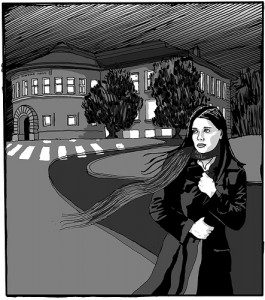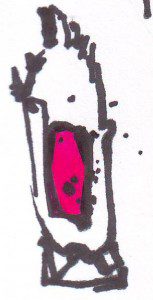 “Any suspicion that literary culture had rushed to sentimentalize an exotic figure of quasi martyrdom was overwhelmed by the intimacy and humor of a voice that earned its breadth line by line, defying traditional fictional form with a torrential insouciance.” – Jonathan Lethem in the New York Times
“Any suspicion that literary culture had rushed to sentimentalize an exotic figure of quasi martyrdom was overwhelmed by the intimacy and humor of a voice that earned its breadth line by line, defying traditional fictional form with a torrential insouciance.” – Jonathan Lethem in the New York Times
“Defying traditional fictional form with a torrential insouciance” is well said of Robert Bolaño, who in 2666 eschews, dismembers, and generally subverts the traditional framework of “the novel.” 2666 exists outside the realm of possibility while appropriating the cliché “fiction is the lie that tells the truth.” For this reason, trying to write a book review of 2666 has left me slightly aphasic.
The best I can do is say Bolaño pulls off the literary equivalent of a traffic accident; your body and time slow down, allowing you extended moments to gape and take it all in, though you feel depraved doing so. And it’s not so much that you do it, but that you do it hungrily. This is a book where a son kills his mother, and when asked why he jammed a piece of wood (murder weapon) into her vagina (cause of death), he says that he did it to teach her “to take him seriously.” Insert onomatopoeic word here.
In the fourth part of the book, a police investigator encounters an attractive insane-asylum director. After a few meetings, they go on a date. On the date, the director lists off phobias and you can just feel the chemistry, the bam-bam-bam of a first date going well. It’s not that the discussion is sensual, it’s just heated, going somewhere, providing something that people or first dates or the 381th page in a novel rarely offer: a conversation that is mind-bending-ly captivating and sustaining. Their date reminds me of the last few pages of Joyce’s Ulysses; this is a prelude to romance and not the finish, yet there’s the similar build, momentum, crescendo to climax, etc.
What follows is a snippet of a few pages out of the many, many hundreds of pages of a preternatural book about (in two words) murder and scholarship. Here are the phobias of Roberto Bolaño’s 2666:
***
The classic fears:
Claustrophobia: “fear of confined spaces”
Gephyrophobia: “the fear of crossing bridges”
Agoraphobia: “fear of open spaces”
Necrophobia: “fear of the dead”
Hemophobia: “fear of blood”
Iatrophobia: “fear of doctors”
***
The religious fears:
Sacraphobia: “fear or hatred of the sacred, of sacred objects, especially from your own religion”
Peccatophobia: “fear of committing sins”
***
The weirder fears:
Clinophobia: “fear of beds” (how to deal with the problem: “sleeping on the floor and never going into a bedroom”)
Tricophobia: “fear of hair” (where some “cases end in suicide”)
Verbophobia: “fear of words” (Verbophobia is more than not speaking “because words are everywhere, even in silence, which is never complete silence.” Another name for fear is Logophobia.)
Vestiphobia: “fear of clothes” (which is “more widespread than you’d expect”)
Gynophobia: “fear of women” (this “naturally afflicts only men” and is “very widespread in Mexico . . . almost all Mexican men are afraid of women”)
***
The romantic fears:
Ombrophobia: “fear of rain”
Thalassophobia: “fear of the sea”
Anthophobia: “fear of flowers”
Dendrophobia: “fear of trees”
***
The still weirder fears:
Optophobia: “fear of opening the eyes” (this is “even worse” than the fear of eyes because “in a literal sense, it leads to violent attacks, loss of consciousness, visual and auditory hallucinations, and generally aggressive behavior”)
Pedophobia: “fear of children”
Ballistopobia: “fear of bullets”
***
Phobias on the rise:
Tropophobia: “fear of making changes or moving”
Agyrophobia: “fear of streets or crossing the street”
***
Fears you yourself probably have but haven’t named:
Ergophobia: “fear of work”
Decidophobia: “fear of making decisions”
Anthrophobia: “fear of people”
Astrophobia: “fear of meteorological phenomena like thunder and lightning”
***
Other fears:
Chromophobia: “fear of certain colors”
Nyctophobia: “fear of night”
***
The worst phobias:
Pantophobia: “fear of everything”
Phobophobia: “fear of fear itself” (Campos comments, “If you’re afraid of your own fears, you’re forced to live in constant contemplation of them, and if they materialize, what you have is a system that feeds on itself, a vicious cycle.”)
***
My list of favorite/interesting fears not mentioned in the book:
Hippopotomonstrosesquippedaliophobia: “fear of long words” (also called Sesquipedalophobia)
Onomatophobia: “fear of hearing a certain word or of names”
Bibliophobia: “fear of books”
***
Why this list? Why do I call it out, and why did Bolaño include it?
For a reader, it hurts to not understand the text, maybe more than someone breaking your heart. Or it hurts the same. It’s the familiar groping and urgency for connection. Bolaño conveys: here are the rules of writing; here I am breaking them. You’re on your own, beloved and broken reader.
There aren’t enough words to describe Bolaño; I’ve run out, run dry, am myself inadequate or under-lingual. Too uni-lingual for sure (this book is translated from Spanish, and I mourn what I’ve lost). Bolaño has a similar, yet half-opposite condition: he uses the same words, sentences, paragraph structures over and over again. And at first it’s maddening. But once you allow the nightmare to take over, it’s exciting (see phobias above).
Whatever 2666 is, it’s not boring. Florita Almada, a seer in the novel, says, “facing boredom head-on [is] an act of bravery and Benito Juárez had done it and she had done it too and both had seen terrible things in the face of boredom, things she would rather not recall.” To me, this is the key to the novel: when 2666 feels traditionally boring (i.e. when it does what “bad” or unpublished novels do: be repetitive, long-winded, or turn lists/statistics/police reports into prose), the content itself is terrifying/interesting as hell (there are three hundred pages of women being murdered, for example).
Not being bored is how I learned to love Bolaño; his unthinkable apertures into the psyche and the real world and how fucked up it can all get. Who is this man, this Bolaño, who encases a list of phobias in a first-date conversation; nudging fear to pull up a third chair and just settle in, infiltrate, nest. Fear of, afraid of, and all while beginning a romance. And it’s encyclopedic, and here it’s at its most organized, and this list is in a novel, and this list occurs on a date, and who writes lists in novels and who discusses lists of fears on dates? I gave myself headaches trying to suss out what the book means. All I wanted to know was why Bolaño made the choices he did. I found some answer around page 600. While discussing the murders, the inspector is back, talking to a colleague, both looking for resolve. The inspector gives advice. The advice is this: “he shouldn’t try to find a logical explanation. . . . It’s fucked up, that’s the only explanation.”
It’s fucked up.
***
First two illustrations by Laurenn McCubbin, third illustration by Zak Smith.




